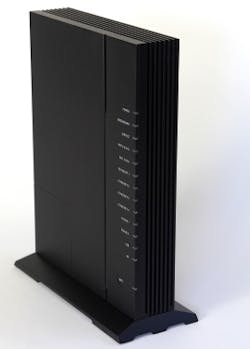Broadband access network equipment provider Calix, Inc. (NYSE: CALX) has unveiled the GigaCenter line of premises service delivery platforms. The units, which combine the functions of an optical network terminal (ONT) and wireless router, combine IEEE 802.11ac "wave 2" 5-GHz-band Wi-Fi and 4x4 Multi-User Multiple Input Multiple Output (MU-MIMO) technology with beamforming capabilities to support delivery of multiple hundreds of megabits – and perhaps symmetrical 1 Gbps – to multiple devices in a home, apartment, small business, and other customer premises. The “carrier class” Wi-Fi capabilities provide several benefits, according to Calix Senior Director of Corporate Marketing Geoff Burke. The raw bandwidth capacity can support as many as eight HD streams simultaneously, in-house tests show; support of 4K video should follow naturally, Burke says. The transmission is powerful enough to remove dead spots within the customer premises as well. The beamforming capability enables the transmission to be partitioned and directed to individual devices for maximum throughput. This combination obviates the need to wire the premises to support high-speed signals, significantly reducing cost and installation time, Burke asserts. Meanwhile, the programmability of the GigaCenters enables both proactive TR-069-based in-site monitoring and maintenance in conjunctions with Calix Compass software as well as the support of a variety of services and configurations via a “service creation engine.” For example, when combined with the beamforming capabilities, a unit could be used in a coffee shop to support multiple users, each with their own for-pay link. Depending upon how much of the configurability service providers want to make available to users, the systems could support self-installation or the ability to reconfigure how much bandwidth is directed at different portions of the premises. The processors within each GigaCenter make the devices ready for implementation of software-defined networking (SDN) concepts as well, Burke says. The line currently comprises two main alternatives, the 844G and 854G; the latter supports potential RF overlay requirements. “International” variants of the two models support power adapters only (the North American versions also support universal power systems) and RF broadcast at 860 MHz. The units will support both 5-GHz and 2.4-GHz operation – high-power 2.4 GHz in the case of the North American version, and medium power in the case of the international version. The 2.4-GHz power levels are regulated by the FCC and EU, respectively. The two initial GigaCenters are designed for GPON fiber to the premises (FTTP) infrastructures based on the Calix E7 Ethernet Service Access Platforms (ESAPs). Future versions also will support point-to-point Ethernet and feature auto-negotiation. Burke says that GigaCenter units are being evaluated in select service provider labs. Calix will be taking initial orders for the GigaCenters late this month, with “broad availability” following this October. Venture Communications Cooperative in Highmore, SD, is one of the service providers now evaluating the product. "Like all service providers facing a highly competitive market environment, we look for new ways to derive operational efficiencies while improving the service experience of our subscribers," said Randy Olsen, assistant general manager at the cooperative, via a Calix press release. "The advanced carrier class Wi-Fi capabilities of the Calix GigaCenter will be a game changer for us -- dramatically reducing our subscriber installation times in our IPTV service areas. Putting a fully managed and monitored network element in the home is also strategically important to Venture, as it gives us the ability to actively manage the home network as well as introduce new cloud-based service possibilities to our subscribers. The GigaCenter provides Venture with a powerful new platform that cements us as the premier broadband provider in our market." For more information on FTTx equipment and suppliers, visit the Lightwave Buyer’s Guide.

About the Author
Stephen Hardy | Editorial Director and Associate Publisher
Stephen Hardy has covered fiber optics for more than 15 years, and communications and technology for more than 30 years. He is responsible for establishing and executing Lightwave's editorial strategy across its digital magazine, website, newsletters, research and other information products. He has won multiple awards for his writing.
Contact Stephen to discuss:
- Contributing editorial material to the Web site or digital magazine
- The direction of a digital magazine issue, staff-written article, or event
- Lightwave editorial attendance at industry events
- Arranging a visit to Lightwave's offices
- Coverage of announcements
- General questions of an editorial nature
Sponsored Recommendations
Sponsored Recommendations
Unveiling the Synergy Between AI and Optical Networking
March 12, 2025
New
New
